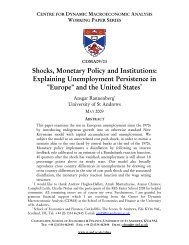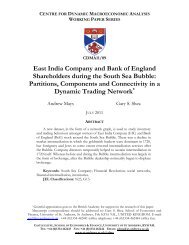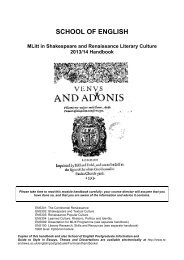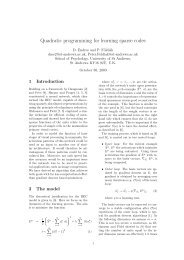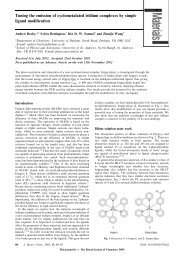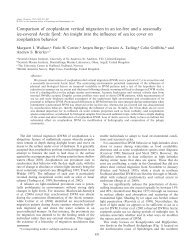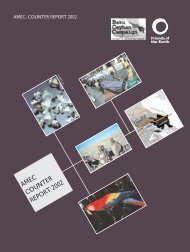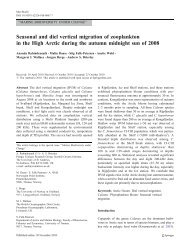Exchange rate dynamics, asset market structure and the role of the ...
Exchange rate dynamics, asset market structure and the role of the ...
Exchange rate dynamics, asset market structure and the role of the ...
You also want an ePaper? Increase the reach of your titles
YUMPU automatically turns print PDFs into web optimized ePapers that Google loves.
<strong>and</strong> foreign intermediate goods in investment goods is set to 1. As <strong>the</strong>re is no clear empirical<br />
evidence on this parameter, I have experimented with several di¤erent values. Our results<br />
are however robust to changing : As is common in <strong>the</strong> real business cycle literature, such as<br />
Hansen (1985), I set <strong>the</strong> share <strong>of</strong> labour in production to 0.64 <strong>and</strong> assume a 2.5% depreciation<br />
<strong>rate</strong> <strong>of</strong> capital per quarter. There is considerable uncertainty regarding <strong>the</strong> curvature <strong>of</strong><br />
<strong>the</strong> investment adjustment cost function s 00 (:): Christiano, et al (2005), who …rst proposed<br />
this speci…cation interpret 1=s 00 (:) as <strong>the</strong> elasticity <strong>of</strong> investment with respect to a 1 percent<br />
temporary increase in <strong>the</strong> current price <strong>of</strong> installed capital. Their empirical evidence suggests<br />
a value <strong>of</strong> s 00 (:) = 2:5. Smets <strong>and</strong> Wouters (2004), estimate this parameter using Bayesian<br />
techniques in <strong>the</strong> context <strong>of</strong> a model <strong>of</strong> <strong>the</strong> US economy. Their median estimate is around 6.<br />
Enders <strong>and</strong> Müller (2008) estimate s 00 (:) in an international real business cycle model, driven<br />
only by productivity shocks. Their estimates are between zero <strong>and</strong> 0.4. Groth <strong>and</strong> Kahn<br />
(2007) look at disaggregated data for <strong>the</strong> UK <strong>and</strong> <strong>the</strong> US <strong>and</strong> for <strong>the</strong> US …nd a value <strong>of</strong> <strong>of</strong><br />
0.17, much lower than Christiano’s estimate based on aggregate data. Given this uncertainty<br />
in <strong>the</strong> literature, I have chosen to set to 0.1. This is delibe<strong>rate</strong>ly small, thus ensuring that<br />
<strong>the</strong> results <strong>of</strong> <strong>the</strong> model are not unduly in‡uenced by a parameter for which <strong>the</strong> literature<br />
does not have a consistent value. This value <strong>of</strong> s 00 (:) allows <strong>the</strong> calib<strong>rate</strong>d model to come<br />
close to matching <strong>the</strong> relative volatility <strong>of</strong> investment to GDP. I perform sensitivity analysis<br />
below to ascertain whe<strong>the</strong>r <strong>the</strong> results <strong>of</strong> this paper are robust to my choice <strong>of</strong> s 00 (:).<br />
Table 1: Baseline calibration<br />
Preferences = 1=1:01; = 1; h = 1=3;<br />
Final goods tech v = (1 v ) = 0:88; = 2; = 1; ' = (1 ' ) = 1<br />
Intermediate goods =<br />
<br />
0:64; = 0:025;<br />
<br />
s 00 = 0:1<br />
0:906 0:088<br />
Shocks =<br />
0:088 0:906<br />
V [] = 10 4 0:726 0:187<br />
0:187 0:726<br />
<br />
The stochastic process for TFP is taken from <strong>the</strong> seminal work <strong>of</strong> Backus et al (1995)<br />
on international real business cycles. The home country in this calibration is assumed to be<br />
<strong>the</strong> United States. Matrix V [] in Table 1 above shows <strong>the</strong> variance-covariance matrix <strong>of</strong><br />
12



